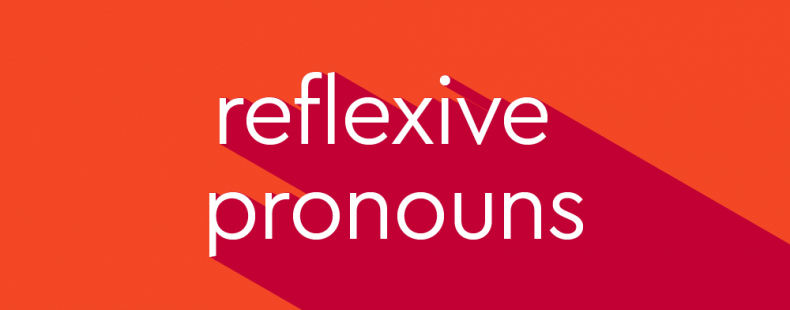Healthy people know how to take care of themselves. A caterpillar wraps itself in a cocoon before it becomes a butterfly. When it comes to grammar, you might consider yourself to be an expert. And if you do, you might have noticed that each of the previous sentences had subjects that were a little self-absorbed. What do we mean by that? Well, when we write sentences, we use pronouns to substitute in for nouns. When the same noun is both the subject and the object, we call on a special type of pronoun known as a reflexive pronoun. But, before we refer to ourselves as grammar masters, let’s learn a bit more about reflexive pronouns.
What is a reflexive pronoun?
A reflexive pronoun is a pronoun used as an object that refers to the same person or thing as the subject. For example, the word herself is a reflexive pronoun in the sentence Nina loves herself because it refers to the same person as the subject Nina; Nina loves Nina.
We use reflexive pronouns when the object of a verb or preposition is the same as the subject of the sentence:
- Becky introduced herself. (The person that Becky introduced was Becky. Becky is both the performer and the receiver of the action.)
- The puppy looked at himself in the mirror. (The thing that the puppy looked at was the puppy. The puppy is both the subject of the sentence and the object of the preposition.)
List of reflexive pronouns
Singular reflexive pronouns
A reflexive pronoun is singular if it refers to exactly one person or thing. The most commonly used reflexive singular pronouns are:
- myself
- yourself
- herself, himself, itself
Plural reflexive pronouns
A reflexive pronoun is plural if it refers to more than one person or thing. The most commonly used plural reflexive pronouns are:
- ourselves
- yourselves
- themselves
Themself
The word themself is sometimes used in nonstandard English as a variant of the word themselves or as a reflexive version of the word they as a singular pronoun to neutrally refer to a person. For example,
- The people can speak for themself. (Themself is used instead of themselves.)
- The shy child sat by themself. (The child’s gender is unknown or not relevant.)
However, the word themself is also used to refer to a person who identifies as nonbinary. Using themself in this context is perfectly acceptable:
- Harley expressed themself through their poetry.
It is important to use the correct pronouns to refer to a person. You can learn more about themself and the singular they in our exploration of the topic.
What is a gender-neutral and nonbinary pronoun?
In the above list of singular reflexive pronouns, the words herself and himself are unique in that they are used to specify a person’s (or animal’s) gender. While these two are the most common, there are plenty of other reflexive pronouns available that don’t carry any kind of association with a particular gender.
It is important not to misidentify someone, even accidentally, by carelessly using gendered language when it isn’t needed. Luckily, there is an easy way to ensure your speech and writing is inclusive of all gender identities: you can use gender-neutral language. If you don’t know which reflexive pronoun is best to use—or would prefer not to use a gendered pronoun at all—the words themselves or themself are what you need.
The pronouns themselves or themself can be (and are increasingly) used as a singular gender-neutral or nonbinary substitute for the gender-specific pronouns himself and herself. (Other terms are also used in this way, but themselves/themself are the most common.) Themselves or themself can be used when you don’t want or need to specify someone’s gender. These pronouns can also be used when referring to a person who identifies as nonbinary. In this case, it’s always important to use the pronouns (and adjectives) that the person prefers.
To learn more, explore in-depth resources about gender-neutral language.
Examples of reflexive pronouns
Let’s look at how we use reflexive pronouns in sentences.
Singular reflexive pronouns
- I ate breakfast by myself.
- We will be busy, so you will have to drive yourself to the airport.
- The baboon puffed itself up to look more intimidating.
- The director made a name for himself with his first movie.
- Alexis painted a picture of herself and her family.
Plural reflexive pronouns
- We groggily dragged ourselves out of bed.
- Hi, everybody! Help yourselves to some pancakes!
- The silly clowns made fools of themselves.
Reflexive pronouns vs. intensive pronouns
Reflexive pronouns are identical in form to another type of pronoun known as intensive pronouns, which also end in -self or -selves. However, these two types of pronouns serve different grammatical functions.
As has been said, reflexive pronouns are used when the object of a sentence or preposition is the same as the subject:
- Mario quickly dressed himself. (Mario is the subject and object of the sentence.)
Intensive pronouns are used to emphasize the subject by repeating it. There are several reasons we may do this, such as pointing out an impressive achievement or noting an odd event.
- The queen herself showed up to the wedding. (The reflexive pronoun emphasizes the subject. No one expected that the queen would be in attendance.)
- My grandfather built this house himself. (The reflexive pronoun emphasizes the subject. It is an impressive achievement to build a house alone or without hiring help.)
How to use reflexive pronouns
Reflexive pronouns are used differently than most other pronouns. The main difference is that reflexive pronouns are not typically used as the subjects of sentences or clauses. For example, we would say Benny went to the movie by himself but we wouldn’t say Himself went to the movie. In order for a sentence to make sense, it must be obvious who or what the reflexive pronoun is referring to.
Standard usage
Each reflexive pronoun corresponds to a personal pronoun. The reflexive pronoun refers to the same person or thing that its personal pronoun does. Each of the commonly used reflexive pronouns are listed below:
- myself: me (the speaker or the writer)
- yourself: you as a singular (another single person besides the speaker/writer)
- itself: it (a thing or an animal)
- himself: him (a male person or animal)
- herself: her (a female person or animal)
- ourselves: us (the speaker/writer and other people together)
- yourselves: you as a plural (other people besides the speaker/writer)
- themselves: them (a group of people, animals, or objects)
- themself: them as a singular (see the usage explanation above.)
If you are unsure which reflexive pronoun to use, think about what the subject is and what personal pronoun you would use if they were the object of the sentence and someone or something else was performing the action:
- The mother squirrel hid ____ in the tree branches.
In the above sentence, we know the subject is the mother squirrel but we are unsure which reflexive pronoun to use. Let’s consider which personal pronoun the mother squirrel would use if it was the object of a different sentence:
- I fed acorns to the mother squirrel.
- I fed acorns to her.
Because the mother squirrel refers to a female animal, we replace this noun phrase with the pronoun her. The reflexive pronoun that corresponds to her is herself. So, we can go back to our original sentence and plug herself into it:
- The mother squirrel hid herself in the tree branches.
Nonstandard usage
As mentioned earlier, we do not typically use reflexive pronouns as the subjects of sentences or clauses. Typically, it is only possible to do this using the passive voice and even then the sentence will often sound confusing or nonsensical:
❌ Incorrect: Ourselves were introduced by us.
✅ Correct: We introduced ourselves.
❌ Incorrect: Myself was cheered up by me.
✅ Correct: I cheered myself up.
A relatively common mistake that people make when it comes to reflexive pronouns is using a reflexive pronoun instead of a personal pronoun (like I, me, he, she). For example,
- If you have any questions, just ask Nancy, Drew, or myself.
In everyday speech and writing, most people would consider the above sentence perfectly acceptable and would easily understand what it is trying to say. However, it does have a grammar mistake that would need to be fixed in formal writing. The mistake is easier to spot if you shorten the sentence:
- If you have any questions, just ask myself.
Do you see it now? The above sentence doesn’t make any sense because the only person who can do something to myself is “I.” (You could say, if I have any questions, I will just ask myself.) Going back to our original sentence, it should read:
- If you have any questions, just ask Nancy, Drew, or me.
Now, the sentence properly uses a personal pronoun; someone can ask me. This common mistake is not an issue in casual writing or speech, but it is something to be aware of in your formal writing.
Grammar Coach™ is here to help you
You’ll never mistake pronouns again when you check your writing on our tool: Thesaurus.com’s Grammar Coach™. This writing tool uses machine learning technology uniquely designed to catch grammar and spelling errors. Its Synonym Swap will find the best nouns, adjectives, and more to help say what you really mean, guiding you toward clearer, stronger, writing.















